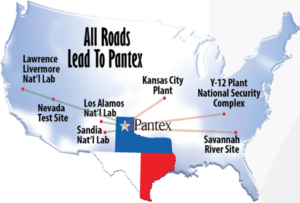
CWP Blog | CWP
Talk to Terrie: Part 1 – History of the Pantex Facility
January 11, 2022
January 11, 2022
CWP
CWP Blog
You asked and we’re answering. You may remember Cold War Patriots asked what subjects you would like to read in our blogs. We received many responses and I appreciate the feedback. One individual requested that the history of Pantex including significant accidents.
Locating a document summarizing the history of Pantex was easy. The plant was first established in 1942, a few years before the development of the atomic bomb. It was the last of 14 munition plants established to produce conventional bombs and artillery shells to help win WWII.
The day after Japan surrendered in August 1945 the Pantex facility was abruptly closed. The US government then leased it to Texas Technological College (now Texas Tech University) for $1.00. The college leased this land for six years. The Atomic Energy Commission (AEC) realized they needed another facility to support the nuclear weapons complex. The AEC ended the lease to the college and reclaimed the land in 1951.
 Image courtesy of the Department of Energy
Image courtesy of the Department of Energy
Pantex was basically the last stop for the nuclear pits. Pantex would marry the nuclear component produced by other Department of Energy (DOE) sites to the high explosives needed to detonate the bomb. Pantex was also responsible for monitoring the degradation of the nuclear stockpile in their possession. Sites such as the Rocky Flats Plant in Colorado would remove the americium which is the result of the decay process of plutonium.
Americium recovery and purification operations shut down in 1980, and work was limited to that required to extract americium from plutonium metal in site returns (ChemRisk 1992) ORAUT-TKBS-0011-2, Rocky Flats Plant – Site Description, Revision 02 (cdc.gov)
The summary states that “Since 1975, Pantex has been the nation’s primary assembly, disassembly, retrofit and modification center for nuclear weapons.”
As you can imagine, the process to connect the nuclear component to the high explosives can be dangerous. The Pantex facility adopted the use of “Gravel Gerties”, a design developed by the Sandia National Lab, to reduce the airborne contamination in the event of an unexpected explosion. The design received that name because the researchers thought the bunker looked a little like the character that appeared in the Dick Tracy comic strip with the same name.
I also located another history which I found a little more interesting. The document is a compilation of the memories of former Pantex workers. The information includes how much people made per week working at the site and how many people were employed there by year from 1952 to 1991. It also contains a lot of historical photos of people and places. While the report is long, it’s definitely worth reading especially by those interested in detailed history.
Don’t miss Part 2 of this blog coming soon which will describe some of the major incidents that occurred at the Pantex Plant.
